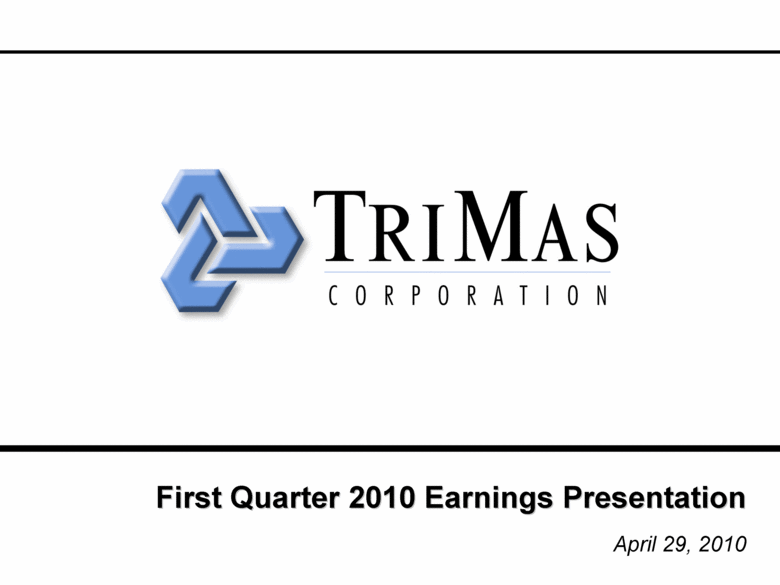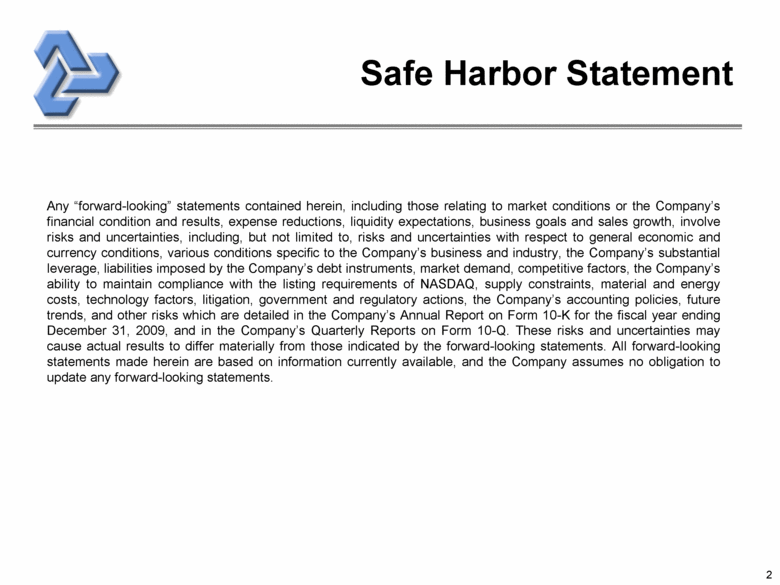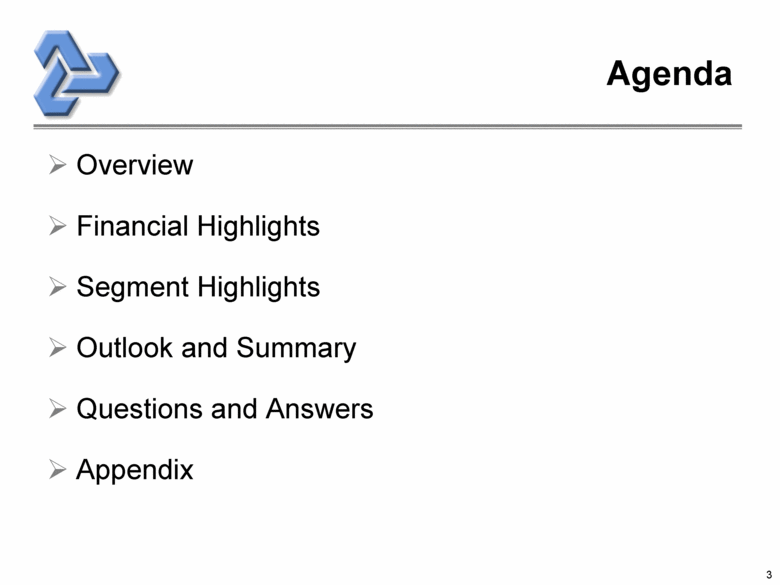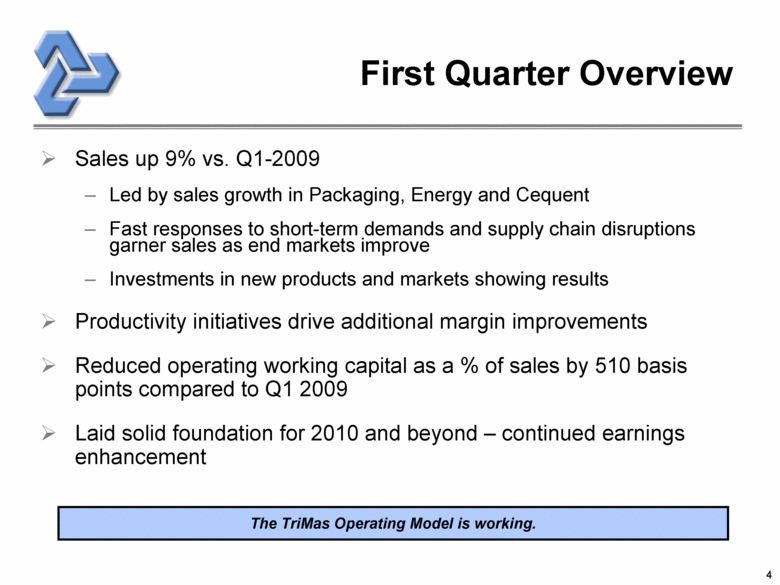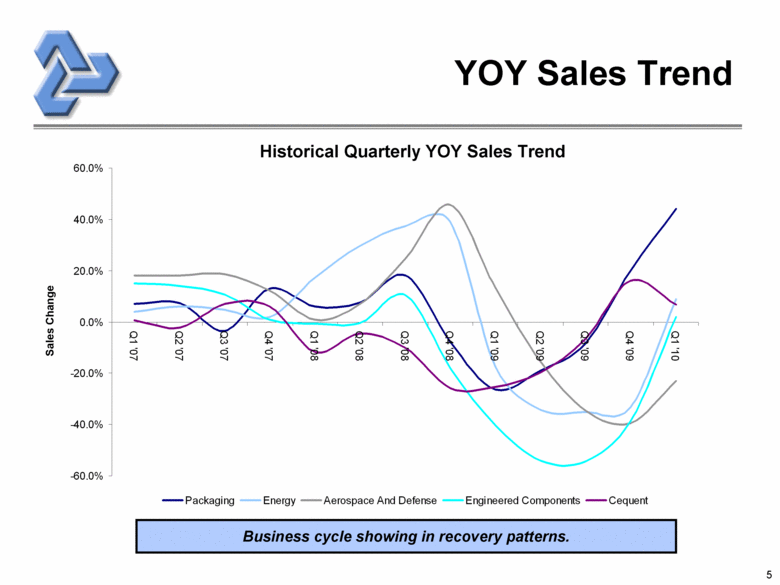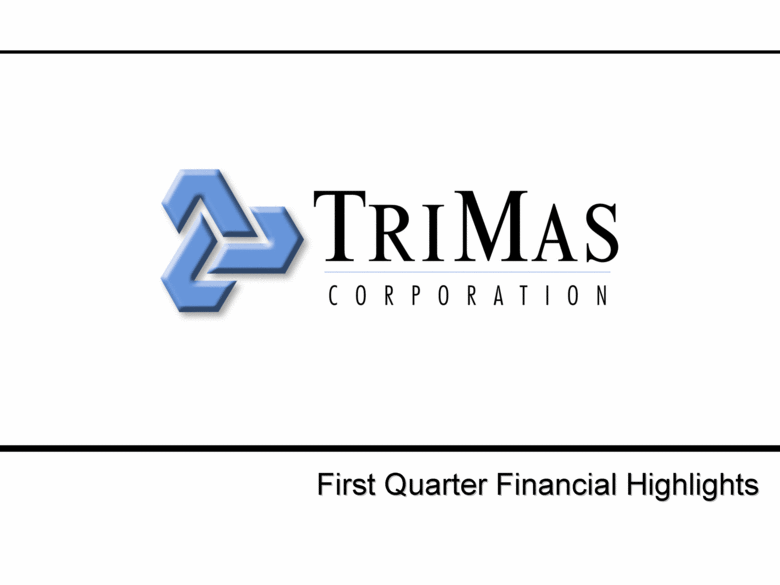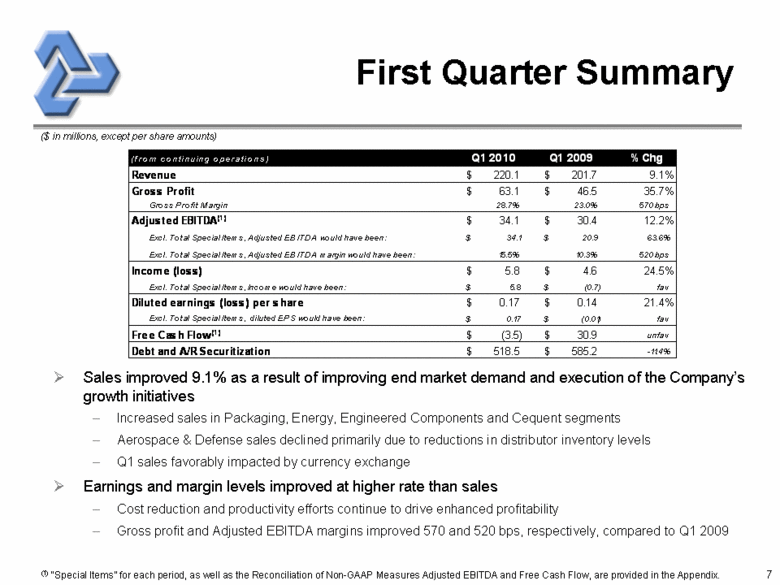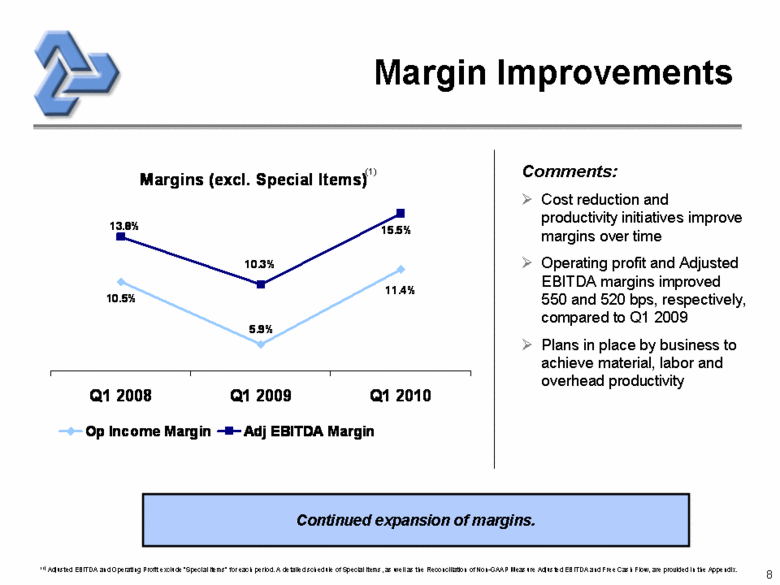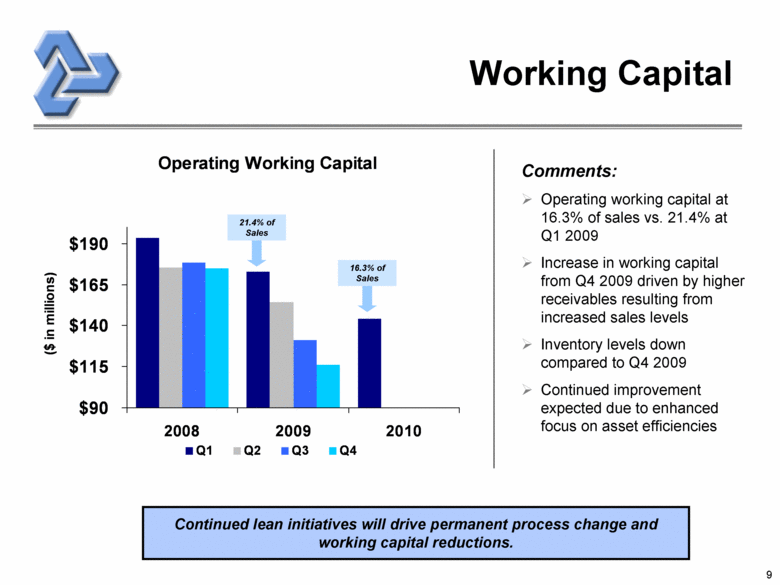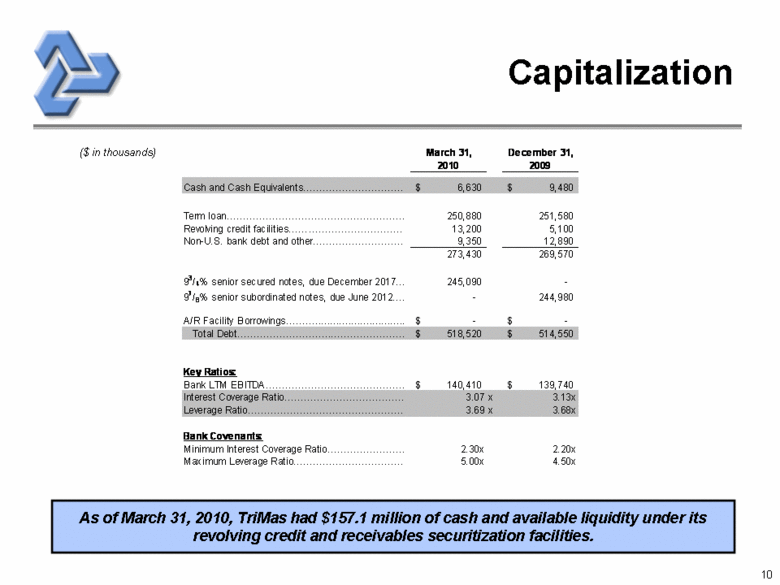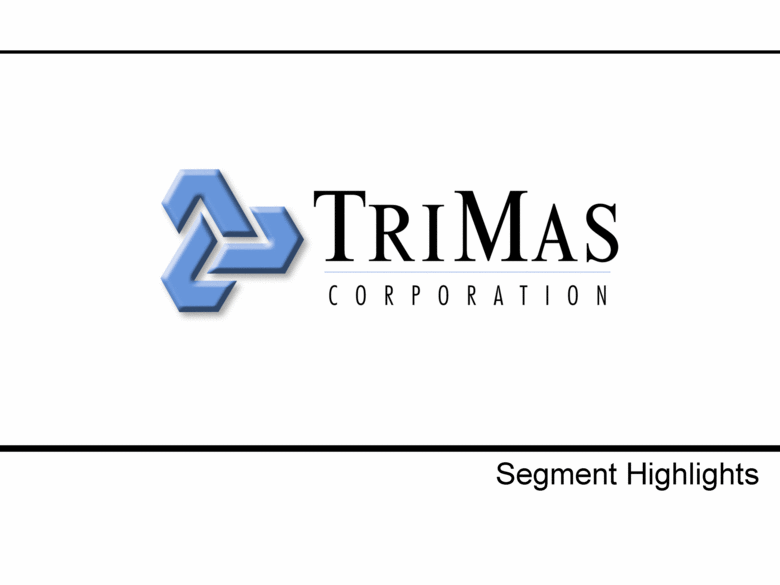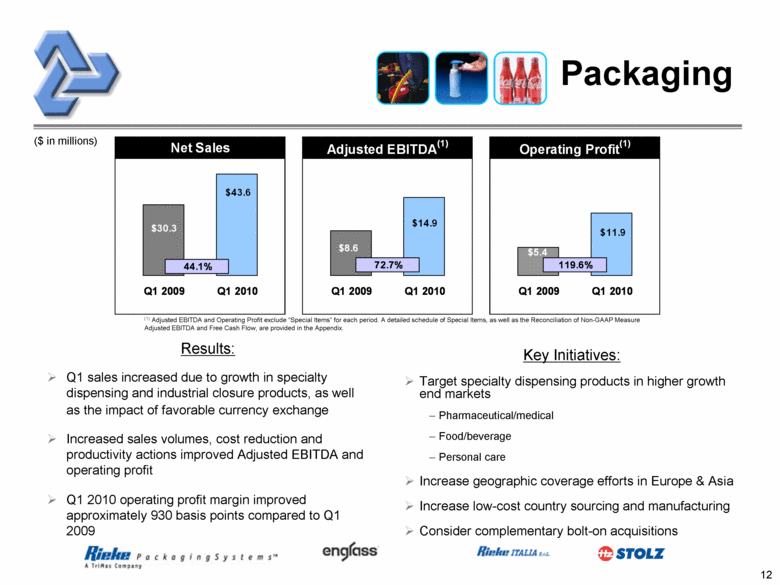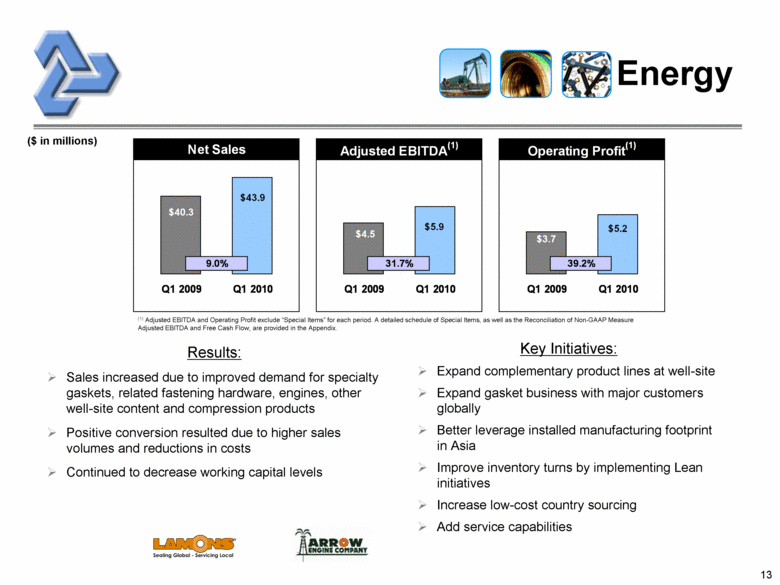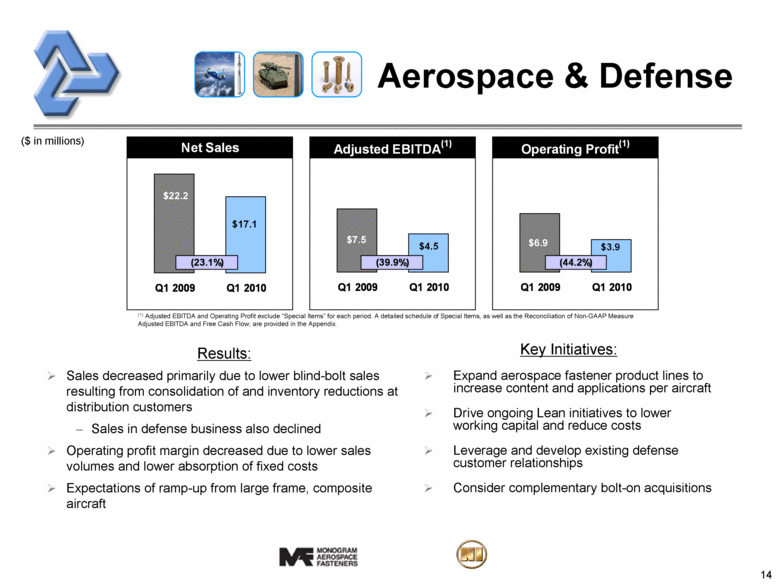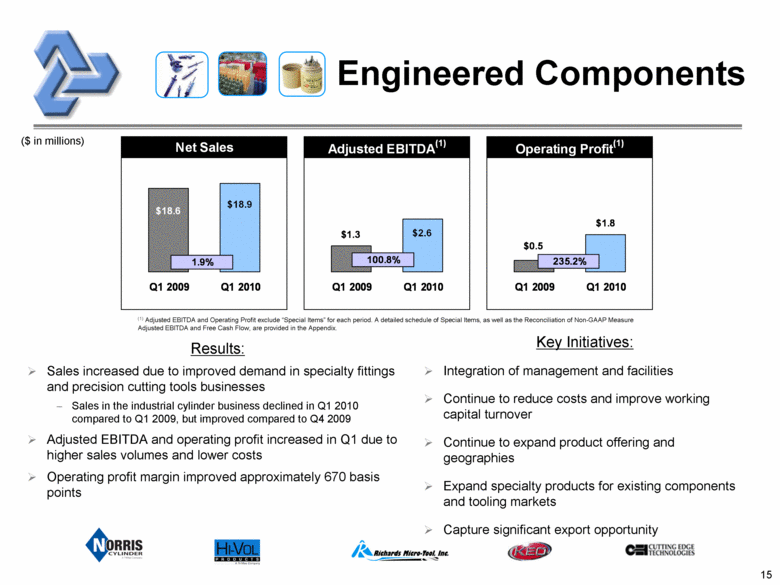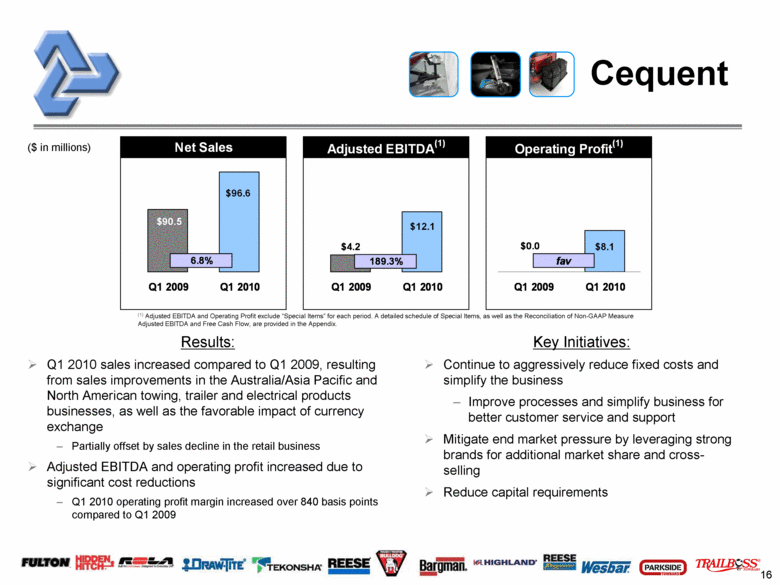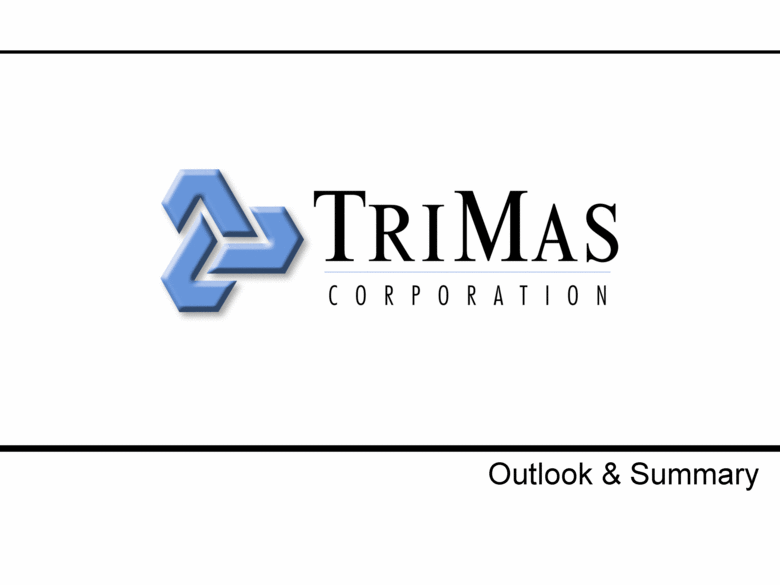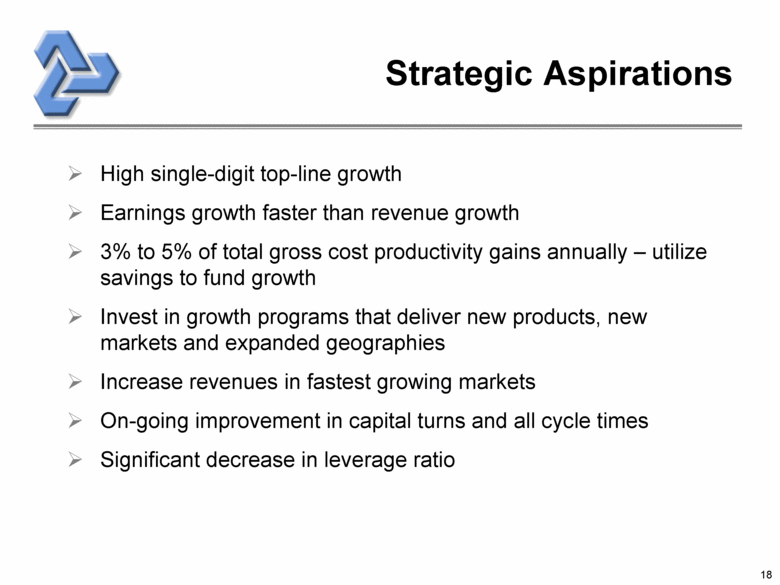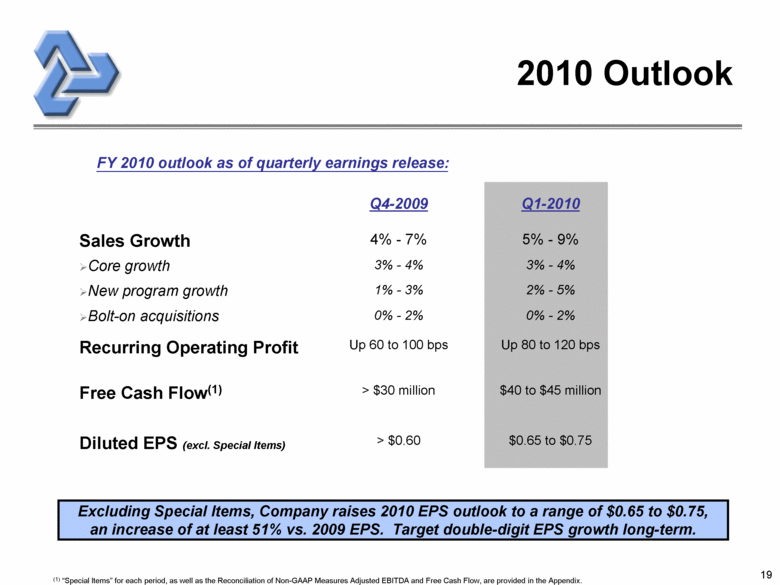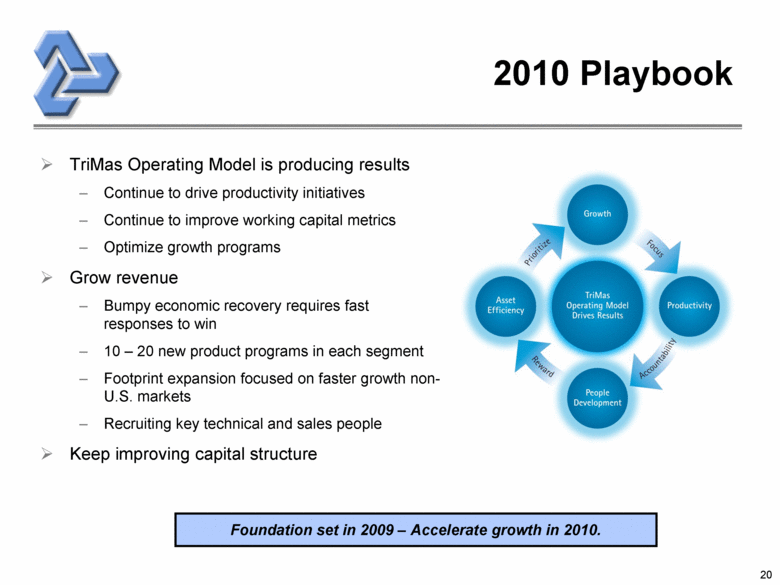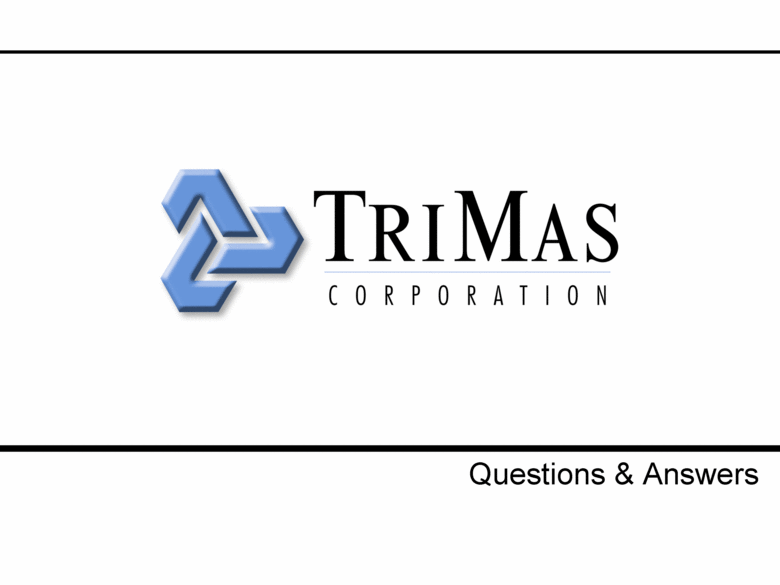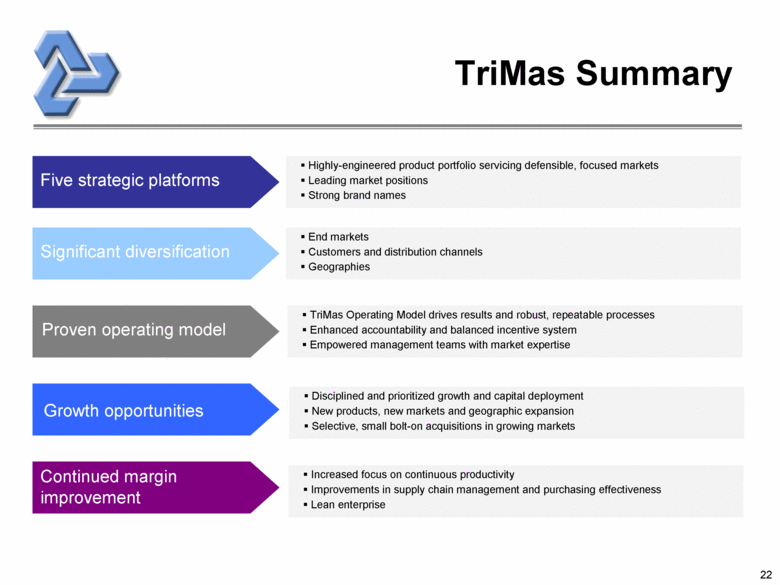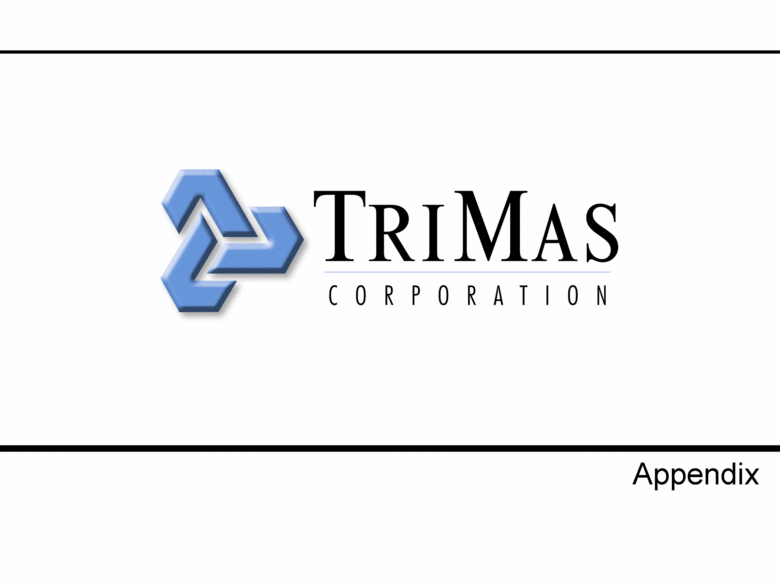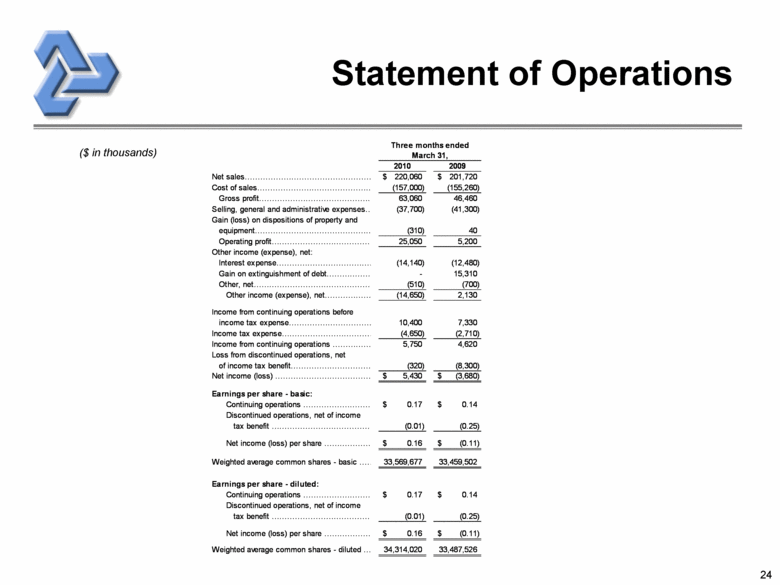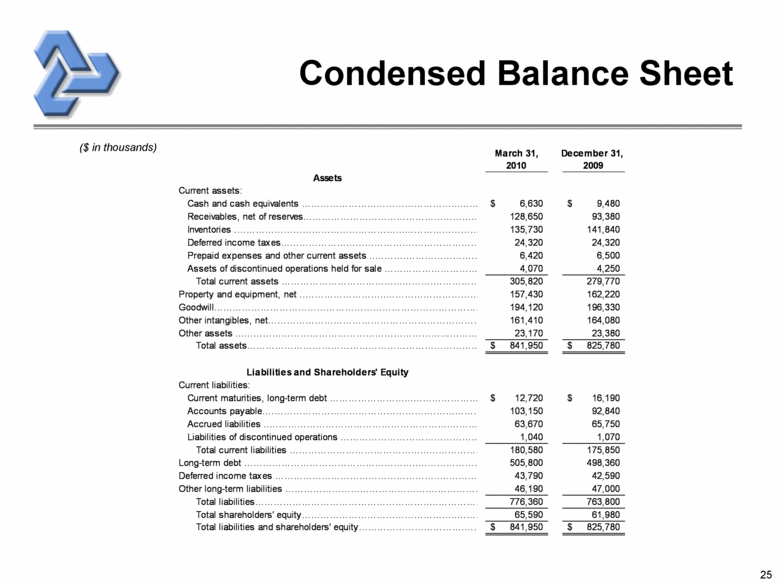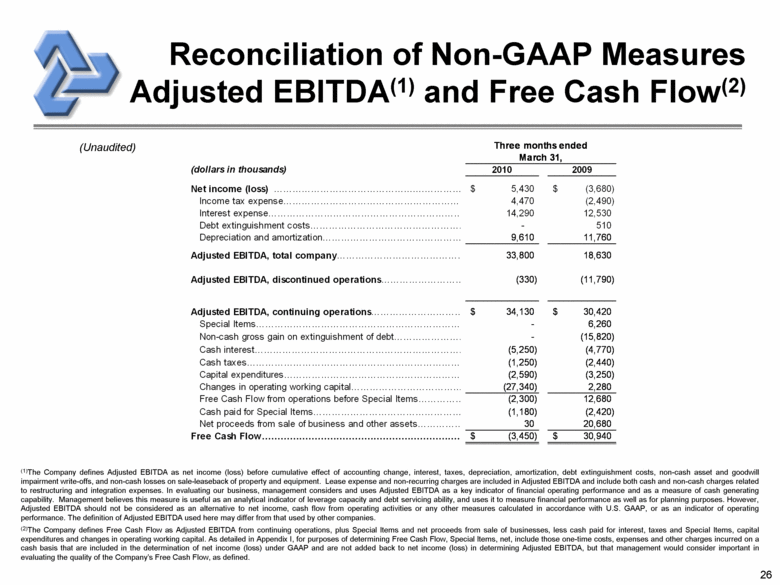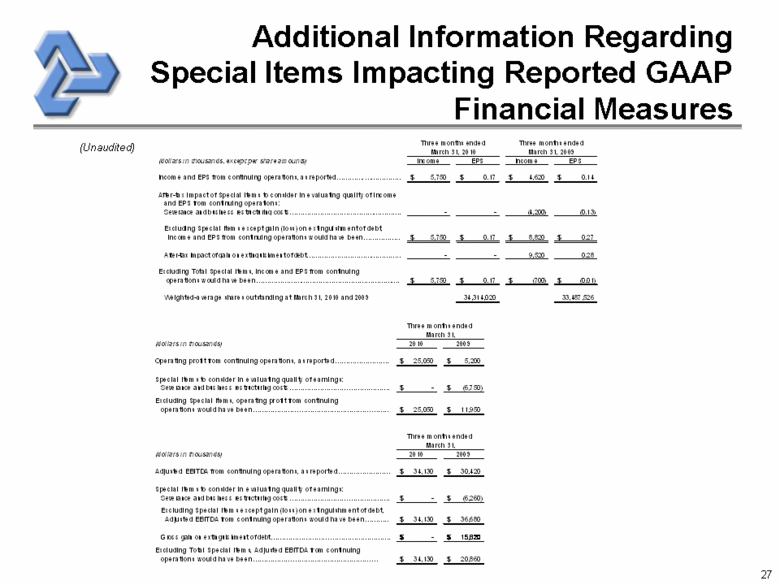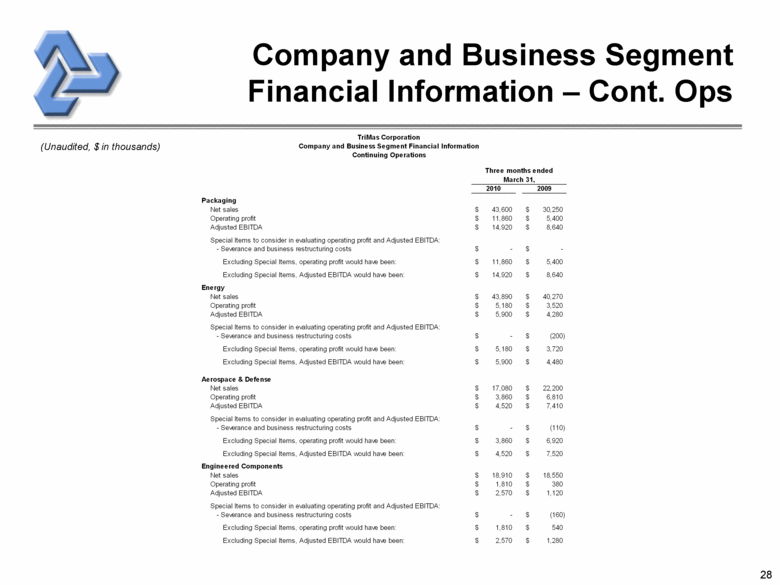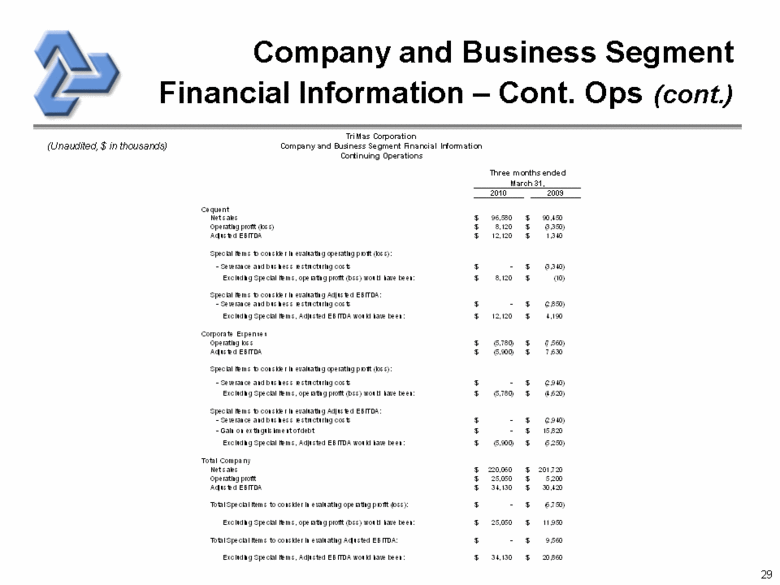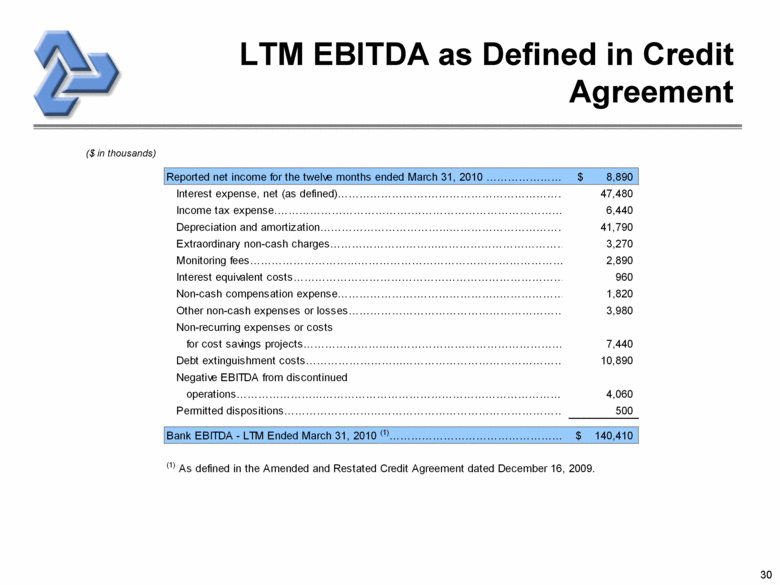Attached files
| file | filename |
|---|---|
| 8-K - 8-K - TRIMAS CORP | a10-8502_18k.htm |
| EX-99.1 - EX-99.1 - TRIMAS CORP | a10-8502_1ex99d1.htm |
Exhibit 99.2
|
|
First Quarter 2010 Earnings Presentation April 29, 2010 |
|
|
Safe Harbor Statement Any “forward-looking” statements contained herein, including those relating to market conditions or the Company’s financial condition and results, expense reductions, liquidity expectations, business goals and sales growth, involve risks and uncertainties, including, but not limited to, risks and uncertainties with respect to general economic and currency conditions, various conditions specific to the Company’s business and industry, the Company’s substantial leverage, liabilities imposed by the Company’s debt instruments, market demand, competitive factors, the Company’s ability to maintain compliance with the listing requirements of NASDAQ, supply constraints, material and energy costs, technology factors, litigation, government and regulatory actions, the Company’s accounting policies, future trends, and other risks which are detailed in the Company’s Annual Report on Form 10-K for the fiscal year ending December 31, 2009, and in the Company’s Quarterly Reports on Form 10-Q. These risks and uncertainties may cause actual results to differ materially from those indicated by the forward-looking statements. All forward-looking statements made herein are based on information currently available, and the Company assumes no obligation to update any forward-looking statements. |
|
|
Agenda Overview Financial Highlights Segment Highlights Outlook and Summary Questions and Answers Appendix |
|
|
4 First Quarter Overview Sales up 9% vs. Q1-2009 Led by sales growth in Packaging, Energy and Cequent Fast responses to short-term demands and supply chain disruptions garner sales as end markets improve Investments in new products and markets showing results Productivity initiatives drive additional margin improvements Reduced operating working capital as a % of sales by 510 basis points compared to Q1 2009 Laid solid foundation for 2010 and beyond – continued earnings enhancement The TriMas Operating Model is working. |
|
|
YOY Sales Trend Historical Quarterly YOY Sales Trend Business cycle showing in recovery patterns. Sales Change -60.0% -40.0% -20.0% 0.0% 20.0% 40.0% 60.0% Q1 '07 Q2 '07 Q3 '07 Q4 '07 Q1 '08 Q2 '08 Q3 '08 Q4 '08 Q1 '09 Q2 '09 Q3 '09 Q4 '09 Q1 '10 Packaging Energy Aerospace And Defense Engineered Components Cequent |
|
|
First Quarter Financial Highlights |
|
|
First Quarter Summary ($ in millions, except per share amounts) Revenue $ 220.1 $ 201.7 9.1% Gross Profit $ 63.1 $ 46.5 35.7% Gross Profit Margin 28.7% 23.0% 570 bps Adjusted EBITDA(1) $ 34.1 $ 30.4 12.2% Excl. Total Special Items, Adjusted EBITDA would have been: $ 34.1 $ 20.9 63.6% Excl. Total Special Items, Adjusted EBITDA margin would have been: 15.5% 10.3% 520 bps Income (loss) $ 5.8 $ 4.6 24.5% Excl. Total Special Items, Income would have been: $ 5.8 $ (0.7) fav Diluted earnings (loss) per share $ 0.17 $ 0.14 21.4% Excl. Total Special Items, diluted EPS would have been: $ 0.17 $ (0.01) fav Free Cash Flow(1) $ (3.5) $ 30.9 unfav Debt and A/R Securitization $ 518.5 $ 585.2 -11.4% Sales improved 9.1% as a result of improving end market demand and execution of the Company’s growth initiatives Increased sales in Packaging, Energy, Engineered Components and Cequent segments Aerospace & Defense sales declined primarily due to reductions in distributor inventory levels Q1 sales favorably impacted by currency exchange Earnings and margin levels improved at higher rate than sales Cost reduction and productivity efforts continue to drive enhanced profitability Gross profit and Adjusted EBITDA margins improved 570 and 520 bps, respectively, compared to Q1 2009 (1) “Special Items” for each period, as well as the Reconciliation of Non-GAAP Measures Adjusted EBITDA and Free Cash Flow, are provided in the Appendix. |
|
|
8 Margin Improvements Continued expansion of margins. Comments: Cost reduction and productivity initiatives improve margins over time Operating profit and Adjusted EBITDA margins improved 550 and 520 bps, respectively, compared to Q1 2009 Plans in place by business to achieve material, labor and overhead productivity (1) Adjusted EBITDA and Operating Profit exclude “Special Items” for each period. A detailed schedule of Special Items, as well as the Reconciliation of Non-GAAP Measure Adjusted EBITDA and Free Cash Flow, are provided in the Appendix. (1) Margins (excl. Special Items) 11.4% 5.9% 10.5% 15.5% 10.3% 13.8% Q1 2008 Q1 2009 Q1 2010 Op Income Margin Adj EBITDA Margin |
|
|
9 Working Capital Continued lean initiatives will drive permanent process change and working capital reductions. Comments: Operating working capital at 16.3% of sales vs. 21.4% at Q1 2009 Increase in working capital from Q4 2009 driven by higher receivables resulting from increased sales levels Inventory levels down compared to Q4 2009 Continued improvement expected due to enhanced focus on asset efficiencies 16.3% of Sales 21.4% of Sales Operating Working Capital $90 $115 $140 $165 $190 2008 2009 2010 ($ in millions) Q1 Q2 Q3 Q4 |
|
|
10 Capitalization ($ in thousands) March 31, December 31, 2010 2009 Cash and Cash Equivalents $ 6,630 $ 9,480 Term loan 250,880 251,580 Revolving credit facilities 13,200 5,100 Non-U.S. bank debt and other 9,350 12,890 273,430 269,570 93/4% senior secured notes, due December 2017 245,090 - 97/8% senior subordinated notes, due June 2012 - 244,980 A/R Facility Borrowings $ - $ - Total Debt $ 518,520 $ 514,550 Key Ratios: Bank LTM EBITDA $ 140,410 $ 139,740 Interest Coverage Ratio 3.07x 3.13x Leverage Ratio 3.69x 3.68x Bank Covenants: Minimum Interest Coverage Ratio 2.30x 2.20x Maximum Leverage Ratio 5.00x 4.50x As of March 31, 2010, TriMas had $157.1 million of cash and available liquidity under its revolving credit and receivables securitization facilities. |
|
|
Segment Highlights |
|
|
12 Packaging Results: Q1 sales increased due to growth in specialty dispensing and industrial closure products, as well as the impact of favorable currency exchange Increased sales volumes, cost reduction and productivity actions improved Adjusted EBITDA and operating profit Q1 2010 operating profit margin improved approximately 930 basis points compared to Q1 2009 ($ in millions) Key Initiatives: Target specialty dispensing products in higher growth end markets Pharmaceutical/medical Food/beverage Personal care Increase geographic coverage efforts in Europe & Asia Increase low-cost country sourcing and manufacturing Consider complementary bolt-on acquisitions (1) Adjusted EBITDA and Operating Profit exclude “Special Items” for each period. A detailed schedule of Special Items, as well as the Reconciliation of Non-GAAP Measure Adjusted EBITDA and Free Cash Flow, are provided in the Appendix. |
|
|
13 Energy ($ in millions) (1) Adjusted EBITDA and Operating Profit exclude “Special Items” for each period. A detailed schedule of Special Items, as well as the Reconciliation of Non-GAAP Measure Adjusted EBITDA and Free Cash Flow, are provided in the Appendix. Results: Sales increased due to improved demand for specialty gaskets, related fastening hardware, engines, other well-site content and compression products Positive conversion resulted due to higher sales volumes and reductions in costs Continued to decrease working capital levels Key Initiatives: Expand complementary product lines at well-site Expand gasket business with major customers globally Better leverage installed manufacturing footprint in Asia Improve inventory turns by implementing Lean initiatives Increase low-cost country sourcing Add service capabilities |
|
|
14 Aerospace & Defense Key Initiatives: Expand aerospace fastener product lines to increase content and applications per aircraft Drive ongoing Lean initiatives to lower working capital and reduce costs Leverage and develop existing defense customer relationships Consider complementary bolt-on acquisitions ($ in millions) Results: Sales decreased primarily due to lower blind-bolt sales resulting from consolidation of and inventory reductions at distribution customers Sales in defense business also declined Operating profit margin decreased due to lower sales volumes and lower absorption of fixed costs Expectations of ramp-up from large frame, composite aircraft (1) Adjusted EBITDA and Operating Profit exclude “Special Items” for each period. A detailed schedule of Special Items, as well as the Reconciliation of Non-GAAP Measure Adjusted EBITDA and Free Cash Flow, are provided in the Appendix. |
|
|
15 Engineered Components ($ in millions) Results: Sales increased due to improved demand in specialty fittings and precision cutting tools businesses Sales in the industrial cylinder business declined in Q1 2010 compared to Q1 2009, but improved compared to Q4 2009 Adjusted EBITDA and operating profit increased in Q1 due to higher sales volumes and lower costs Operating profit margin improved approximately 670 basis points Key Initiatives: Integration of management and facilities Continue to reduce costs and improve working capital turnover Continue to expand product offering and geographies Expand specialty products for existing components and tooling markets Capture significant export opportunity (1) Adjusted EBITDA and Operating Profit exclude “Special Items” for each period. A detailed schedule of Special Items, as well as the Reconciliation of Non-GAAP Measure Adjusted EBITDA and Free Cash Flow, are provided in the Appendix. |
|
|
16 Cequent ($ in millions) $46.4 Results: Q1 2010 sales increased compared to Q1 2009, resulting from sales improvements in the Australia/Asia Pacific and North American towing, trailer and electrical products businesses, as well as the favorable impact of currency exchange Partially offset by sales decline in the retail business Adjusted EBITDA and operating profit increased due to significant cost reductions Q1 2010 operating profit margin increased over 840 basis points compared to Q1 2009 Key Initiatives: Continue to aggressively reduce fixed costs and simplify the business Improve processes and simplify business for better customer service and support Mitigate end market pressure by leveraging strong brands for additional market share and cross-selling Reduce capital requirements (1) Adjusted EBITDA and Operating Profit exclude “Special Items” for each period. A detailed schedule of Special Items, as well as the Reconciliation of Non-GAAP Measure Adjusted EBITDA and Free Cash Flow, are provided in the Appendix. |
|
|
Outlook & Summary |
|
|
18 Strategic Aspirations High single-digit top-line growth Earnings growth faster than revenue growth 3% to 5% of total gross cost productivity gains annually – utilize savings to fund growth Invest in growth programs that deliver new products, new markets and expanded geographies Increase revenues in fastest growing markets On-going improvement in capital turns and all cycle times Significant decrease in leverage ratio |
|
|
19 2010 Outlook Up 80 to 120 bps Up 60 to 100 bps Recurring Operating Profit $40 to $45 million > $30 million Free Cash Flow(1) $0.65 to $0.75 > $0.60 Diluted EPS (excl. Special Items) 0% - 2% 2% - 5% 3% - 4% 5% - 9% Q1-2010 Q4-2009 Sales Growth 4% - 7% Core growth 3% - 4% New program growth 1% - 3% Bolt-on acquisitions 0% - 2% (1) “Special Items” for each period, as well as the Reconciliation of Non-GAAP Measures Adjusted EBITDA and Free Cash Flow, are provided in the Appendix. FY 2010 outlook as of quarterly earnings release: Excluding Special Items, Company raises 2010 EPS outlook to a range of $0.65 to $0.75, an increase of at least 51% vs. 2009 EPS. Target double-digit EPS growth long-term. |
|
|
20 2010 Playbook TriMas Operating Model is producing results Continue to drive productivity initiatives Continue to improve working capital metrics Optimize growth programs Grow revenue Bumpy economic recovery requires fast responses to win 10 – 20 new product programs in each segment Footprint expansion focused on faster growth non-U.S. markets Recruiting key technical and sales people Keep improving capital structure Foundation set in 2009 – Accelerate growth in 2010. |
|
|
Questions & Answers |
|
|
22 TriMas Summary Five strategic platforms Highly-engineered product portfolio servicing defensible, focused markets Leading market positions Strong brand names Significant diversification End markets Customers and distribution channels Geographies Proven operating model TriMas Operating Model drives results and robust, repeatable processes Enhanced accountability and balanced incentive system Empowered management teams with market expertise Growth opportunities Disciplined and prioritized growth and capital deployment New products, new markets and geographic expansion Selective, small bolt-on acquisitions in growing markets Continued margin improvement Increased focus on continuous productivity Improvements in supply chain management and purchasing effectiveness Lean enterprise |
|
|
Appendix |
|
|
24 Statement of Operations ($ in thousands) Three months ended March 31, 2010 2009 Net sales $ 220,060 $ 201,720 Cost of sales (157,000) (155,260) Gross profit 63,060 46,460 Selling, general and administrative expenses (37,700) (41,300) Gain (loss) on dispositions of property and equipment (310) 40 Operating profit 25,050 5,200 Other income (expense), net: Interest expense (14,140) (12,480) Gain on extinguishment of debt - 15,310 Other, net (510) (700) Other income (expense), net (14,650) 2,130 Income from continuing operations before income tax expense 10,400 7,330 Income tax expense (4,650) (2,710) Income from continuing operations. 5,750 4,620 Loss from discontinued operations, net of income tax benefit (320) (8,300) Net income (loss) .. $ 5,430 $ (3,680) Earnings per share - basic: Continuing operations $ 0.17 $ 0.14 Discontinued operations, net of income tax benefit (0.01) (0.25) Net income (loss) per share $ 0.16 $ (0.11) Weighted average common shares - basic 33,569,677 33,459,502 Earnings per share - diluted: Continuing operations $ 0.17 $ 0.14 Discontinued operations, net of income tax benefit (0.01) (0.25) Net income (loss) per share $ 0.16 $ (0.11) Weighted average common shares - diluted 34,314,020 33,487,526 |
|
|
25 Condensed Balance Sheet ($ in thousands) March 31, December 31, 2010 2009 Assets Current assets: Cash and cash equivalents $ 6,630 $ 9,480 Receivables, net of reserves 128,650 93,380 Inventories 135,730 141,840 Deferred income taxes 24,320 24,320 Prepaid expenses and other current assets 6,420 6,500 Assets of discontinued operations held for sale 4,070 4,250 Total current assets 305,820 279,770 Property and equipment, net 157,430 162,220 Goodwill 194,120 196,330 Other intangibles, net 161,410 164,080 Other assets 23,170 23,380 Total assets $ 841,950 $ 825,780 Liabilities and Shareholders’ Equity Current liabilities: Current maturities, long-term debt $ 12,720 $ 16,190 Accounts payable 103,150 92,840 Accrued liabilities 63,670 65,750 Liabilities of discontinued operations 1,040 1,070 Total current liabilities 180,580 175,850 Long-term debt 505,800 498,360 Deferred income taxes 43,790 42,590 Other long-term liabilities 46,190 47,000 Total liabilities 776,360 763,800 Total shareholders’ equity 65,590 61,980 Total liabilities and shareholders’ equity $ 841,950 $ 825,780 |
|
|
26 Reconciliation of Non-GAAP Measures Adjusted EBITDA(1) and Free Cash Flow(2) Three months ended March 31, (dollars in thousands) 2010 2009 Net income (loss) $ 5,430 $ (3,680) Income tax expense 4,470 (2,490) Interest expense 14,290 12,530 Debt extinguishment costs — 510 Depreciation and amortization 9,610 11,760 Adjusted EBITDA, total company 33,800 18,630 Adjusted EBITDA, discontinued operations (330) (11,790) Adjusted EBITDA, continuing operations $ 34,130 $ 30,420 Special Items — 6,260 Non-cash gross gain on extinguishment of debt — (15,820) Cash interest (5,250) (4,770) Cash taxes (1,250) (2,440) Capital expenditures (2,590) (3,250) Changes in operating working capital (27,340) 2,280 Free Cash Flow from operations before Special Items (2,300) 12,680 Cash paid for Special Items (1,180) (2,420) Net proceeds from sale of business and other assets 30 20,680 Free Cash Flow $ (3,450) $ 30,940 (1)The Company defines Adjusted EBITDA as net income (loss) before cumulative effect of accounting change, interest, taxes, depreciation, amortization, debt extinguishment costs, non-cash asset and goodwill impairment write-offs, and non-cash losses on sale-leaseback of property and equipment. Lease expense and non-recurring charges are included in Adjusted EBITDA and include both cash and non-cash charges related to restructuring and integration expenses. In evaluating our business, management considers and uses Adjusted EBITDA as a key indicator of financial operating performance and as a measure of cash generating capability. Management believes this measure is useful as an analytical indicator of leverage capacity and debt servicing ability, and uses it to measure financial performance as well as for planning purposes. However, Adjusted EBITDA should not be considered as an alternative to net income, cash flow from operating activities or any other measures calculated in accordance with U.S. GAAP, or as an indicator of operating performance. The definition of Adjusted EBITDA used here may differ from that used by other companies. (2)The Company defines Free Cash Flow as Adjusted EBITDA from continuing operations, plus Special Items and net proceeds from sale of businesses, less cash paid for interest, taxes and Special Items, capital expenditures and changes in operating working capital. As detailed in Appendix I, for purposes of determining Free Cash Flow, Special Items, net, include those one-time costs, expenses and other charges incurred on a cash basis that are included in the determination of net income (loss) under GAAP and are not added back to net income (loss) in determining Adjusted EBITDA, but that management would consider important in evaluating the quality of the Company’s Free Cash Flow, as defined. (Unaudited) |
|
|
27 Additional Information Regarding Special Items Impacting Reported GAAP Financial Measures (Unaudited) Three months ended March 31, (dollars in thousands) 2010 2009 Operating profit from continuing operations, as reported $ 25,050 $ 5,200 Special Items to consider in evaluating quality of earnings: Severance and business restructuring costs $ — $ (6,750 ) Excluding Special Items, operating profit from continuing operations would have been $ 25,050 $ 11,950 Three months ended March 31, (dollars in thousands) 2010 2009 Adjusted EBITDA from continuing operations, as reported $ 34,130 $ 30,420 Special Items to consider in evaluating quality of earnings: Severance and business restructuring costs $ - $ (6,260 ) Excluding Special Items except gain (loss) on extinguishment of debt, Adjusted EBITDA from continuing operations would have been $ 34,130 $ 36,680 Gross gain on extinguishment of debt $ - $ 15,820 Excluding Total Special Items, Adjusted EBITDA from continuing operations would have been $ 34,130 $ 20,860 |
|
|
28 Company and Business Segment Financial Information – Cont. Ops (Unaudited, $ in thousands) Three months ended March 31, 2010 2009 Packaging Net sales $ 43,600 $ 30,250 Operating profit $ 11,860 $ 5,400 Adjusted EBITDA $ 14,920 $ 8,640 Special Items to consider in evaluating operating profit and Adjusted EBITDA: - Severance and business restructuring costs $ - $ - Excluding Special Items, operating profit would have been: $ 11,860 $ 5,400 Excluding Special Items, Adjusted EBITDA would have been: $ 14,920 $ 8,640 Energy Net sales $ 43,890 $ 40,270 Operating profit $ 5,180 $ 3,520 Adjusted EBITDA $ 5,900 $ 4,280 Special Items to consider in evaluating operating profit and Adjusted EBITDA: - Severance and business restructuring costs $ - $ (200) Excluding Special Items, operating profit would have been: $ 5,180 $ 3,720 Excluding Special Items, Adjusted EBITDA would have been: $ 5,900 $ 4,480 Aerospace & Defense Net sales $ 17,080 $ 22,200 Operating profit $ 3,860 $ 6,810 Adjusted EBITDA $ 4,520 $ 7,410 Special Items to consider in evaluating operating profit and Adjusted EBITDA: - Severance and business restructuring costs $ - $ (110) Excluding Special Items, operating profit would have been: $ 3,860 $ 6,920 Excluding Special Items, Adjusted EBITDA would have been: $ 4,520 $ 7,520 Engineered Components Net sales $ 18,910 $ 18,550 Operating profit $ 1,810 $ 380 Adjusted EBITDA $ 2,570 $ 1,120 Special Items to consider in evaluating operating profit and Adjusted EBITDA: - Severance and business restructuring costs $ - $ (160) Excluding Special Items, operating profit would have been: $ 1,810 $ 540 Excluding Special Items, Adjusted EBITDA would have been: $ 2,570 $ 1,280 |
|
|
29 Company and Business Segment Financial Information – Cont. Ops (cont.) (Unaudited, $ in thousands) Cequent Net sales $ 96,580 $ 90,450 Operating profit (loss) $ 8,120 $ (3,350) Adjusted EBITDA $ 12,120 $ 1,340 Special Items to consider in evaluating operating profit (loss): - Severance and business restructuring costs $ - $ (3,340) Excluding Special Items, operating profit (loss) would have been: $ 8,120 $ (10) Special Items to consider in evaluating Adjusted EBITDA: - Severance and business restructuring costs $ - $ (2,850) Excluding Special Items, Adjusted EBITDA would have been: $ 12,120 $ 4,190 Corporate Expenses Operating loss $ (5,780) $ (7,560) Adjusted EBITDA $ (5,900) $ 7,630 Special Items to consider in evaluating operating profit (loss): - Severance and business restructuring costs $ - $ (2,940) Excluding Special Items, operating profit (loss) would have been: $ (5,780) $ (4,620) Special Items to consider in evaluating Adjusted EBITDA: - Severance and business restructuring costs $ - $ (2,940) - Gain on extinguishment of debt $ - $ 15,820 Excluding Special Items, Adjusted EBITDA would have been: $ (5,900) $ (5,250) Total Company Net sales $ 220,060 $ 201,720 Operating profit $ 25,050 $ 5,200 Adjusted EBITDA $ 34,130 $ 30,420 Total Special Items to consider in evaluating operating profit (loss): $ - $ (6,750) Excluding Special Items, operating profit (loss) would have been: $ 25,050 $ 11,950 Total Special Items to consider in evaluating Adjusted EBITDA: $ - $ 9,050 Excluding Special Items, Adjusted EBITDA would have been: $ 34,130 $ 20,860 |
|
|
30 ($ in thousands) LTM EBITDA as Defined in Credit Agreement Reported net income for the twelve months ended March 31, 2010 $ 8,890 Interest expense, net (as defined) 47,480 Income tax expense 6,440 Depreciation and amortization 41,790 Extraordinary non-cash charges 3,270 Monitoring fees 2,890 Interest equivalent costs 960 Non-cash compensation expense 1,820 Other non-cash expenses or losses 3,980 Non-recurring expenses or costs for cost savings projects 7,440 Debt extinguishment costs 10,890 Negative EBITDA from discontinued operations 4,060 Permitted dispositions 500 Bank EBITDA - LTM Ended March 31, 2010 (1) $ 140,410 (1) As defined in the Amended and Restated Credit Agreement dated December 16, 2009. |

